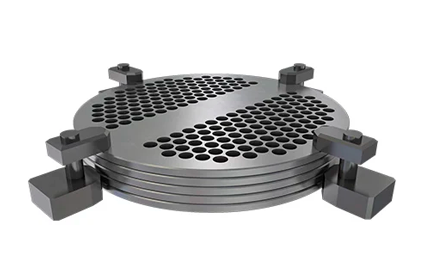Introduction
Heat exchanger baffles are essential components that significantly influence the performance and efficiency of heat exchangers. Positioned strategically within the shell, these elements guide the flow of fluids, creating turbulence that enhances heat transfer between the tube and shell sides. Beyond their thermal role, baffles provide mechanical support to the tube bundle, preventing damage from vibrations and ensuring the structural integrity of the heat exchanger. With various designs like segmental, rod, and helical baffles, these components can be tailored to meet the specific thermal, hydraulic, and operational requirements of diverse industries. Their importance in optimizing heat exchanger functionality underscores their value in both traditional and advanced thermal systems.
Key Functions of Heat Exchanger Baffles
- Improved Heat Transfer Efficiency
Baffles force the shell-side fluid to flow across the tubes in a zigzag pattern, increasing turbulence and improving the heat transfer rate. This reduces the likelihood of laminar flow, where heat transfer is less efficient. - Tube Support and Vibration Reduction
By holding the tubes in place, baffles prevent vibration caused by fluid flow and external forces. This support minimizes wear and tear, prolonging the lifespan of the heat exchanger. - Flow Distribution
Baffles evenly distribute the fluid across the heat exchanger’s tube bundle, preventing dead zones and ensuring uniform heat transfer throughout the unit. - Pressure Drop Management
While increasing turbulence improves heat transfer, it also causes a pressure drop. Baffle design aims to strike a balance between enhancing heat transfer and minimizing pressure loss.
Types of Baffles in Heat Exchangers
- Segmental Baffles
The most common type, segmental baffles, are semicircular plates placed alternately on the top and bottom of the heat exchanger. They create a zigzag flow pattern, enhancing turbulence and heat transfer efficiency. Variants include single-segmental, double-segmental, and multi-segmental designs. - Rod Baffles
These baffles use rods and support structures to guide fluid flow while reducing pressure drop. Rod baffles are ideal for applications where minimizing pressure loss is critical, such as in gas cooling systems. - Disk and Doughnut Baffles
Disk and doughnut baffles feature alternating disk and ring shapes. They provide controlled turbulence while reducing the risk of fouling, making them suitable for applications with dirty fluids. - Orifice Baffles
Orifice baffles have holes to allow fluid to pass through while maintaining controlled flow. They are used in cases where precise flow control is required, such as in chemical processing. - Helical Baffles
Helical baffles are designed in a spiral configuration, promoting a continuous flow path along the tubes. They reduce pressure drop and fouling, making them ideal for fouling-prone and high-viscosity fluids.
Design Considerations for Heat Exchanger Baffles
- Baffle Spacing
The distance between baffles influences heat transfer efficiency and pressure drop. Closer spacing increases turbulence and heat transfer but results in higher pressure loss. Optimal spacing depends on the application’s thermal and hydraulic requirements. - Baffle Cut
The baffle cut refers to the proportion of the baffle removed to allow fluid flow. Common cuts range between 20% to 45%. Larger cuts reduce pressure drop but may compromise heat transfer efficiency. - Material Selection
Baffles must be made from materials compatible with the operating environment to prevent corrosion and wear. Common materials include stainless steel, carbon steel, and corrosion-resistant alloys. - Alignment with Tube Bundle
Proper alignment of baffles with the tube bundle ensures even fluid distribution and structural integrity, reducing the risk of vibration and mechanical damage.
Applications of Heat Exchanger Baffles
- Petrochemical and Oil Refining
In petrochemical plants and oil refineries, baffles enhance heat transfer in shell-and-tube heat exchangers used for processes like crude oil preheating, distillation, and cooling. - Power Generation
Heat exchangers in power plants rely on baffles for efficient heat transfer in steam condensers, turbine cooling, and feedwater heaters. - Chemical Processing
In chemical industries, baffles ensure uniform heating or cooling of process fluids, essential for maintaining product quality and reaction efficiency. - HVAC Systems
Baffles in heat exchangers used in HVAC systems improve heat transfer between refrigerants and air, ensuring efficient heating and cooling. - Food and Beverage Industry
Heat exchangers in food processing require baffles to facilitate even heating or cooling while minimizing the risk of contamination.
Advantages of Heat Exchanger Baffles
- Enhanced Heat Transfer
By promoting turbulence and improving flow distribution, baffles significantly boost the heat exchanger’s thermal efficiency. - Structural Integrity
Baffles provide mechanical support to the tube bundle, reducing the risk of vibration-induced damage and increasing the equipment’s durability. - Flexibility in Design
Various baffle types and configurations allow customization to meet specific thermal and hydraulic requirements for diverse applications. - Fouling Reduction
Some baffle designs, such as helical or rod baffles, reduce the risk of fouling by minimizing stagnant zones and promoting self-cleaning flow patterns.
Challenges and Solutions in Baffle Design
- Pressure Drop
Increased turbulence caused by baffles can lead to significant pressure drops, affecting system efficiency. Optimized baffle spacing and cuts help mitigate this issue. - Corrosion and Wear
Prolonged exposure to aggressive fluids can lead to corrosion of baffles. Using corrosion-resistant materials and coatings ensures longevity. - Fouling
In applications with dirty fluids, fouling can accumulate around baffles. Designs such as helical baffles and regular maintenance help address this challenge.
Conclusion
In the dynamic field of heat exchanger technology, baffles are more than structural aids; they are the backbone of efficient and reliable thermal performance. By fostering enhanced heat transfer, reducing fouling, and providing critical tube support, baffles ensure that heat exchangers operate optimally even in demanding conditions. Their adaptability in design and material selection enables them to address industry-specific challenges, from minimizing pressure drops to handling aggressive and fouling-prone fluids. As industries evolve, so too will baffle innovations, paving the way for more efficient and sustainable heat exchange solutions. Ultimately, heat exchanger baffles remain indispensable for modern engineering, bridging the gap between performance and durability in thermal systems.

